The hard drive of BOINC zombie #4 seems shot. It’s making weird ticking noises, and when I rebooted, (after unplugging it) the filesystem was so shot it couldn’t recover from the damage to the point there was no hostname – it showed up as (none) – and I couldn’t even log in. I couldn’t even reboot with ctrl-alt-del! I was figuring I’d reinstall Debian, but given how awful the hard drive sounds I figured it wouldn’t even be worth the effort. Then I realized that since it seemed all the other bits and pieces of the machine seemed to be in working order, I could run it as a live system of a CD! As luck would have it, Debian has official live CDs. So now I think I’ll wipe the drive, add it to the pile of drives to be recycled, and start running zombie #4 off a live system. It might not be as snappy, but the entire CD image is only 106MB!
Category: Hardware
Malasysia
How many of you knew where Malaysia is? I didn’t either. It’s here. It’s a rather small country in southeast Asia. They’re getting a huge rollout of 224 megabits per second (direction not specified) broadband over power (Internet over power lines – plug an adapter into a wall socket and off you go) for $1.58 per month. FiOS is about the fastest thing available at an average consumer level, (and it’s nowhere near national rollout at this point) and it costs $43-$50 per month, offering up to 50 megabits per second downstream and up to 20 megabits per second upstream. If they can do it, why can’t we?
I’ve read about this huge island of plastic in the Pacific Ocean, but I’ve never seen it. I looked on Google Earth – it isn’t there. It makes sense to me why Google wouldn’t take extensive pictures of the ocean – in the most part it’d be a waste of satellite power. I recently found a series in which some people get a boat and go out to this patch of plastic. It’s thought-provoking. You can watch it here.
On the subject of satellites: space is full of them. Not just operational satellites, but shards of them. Here’s a picture.
BOINC Zombies!
I’m done! I set up all four new BOINC zombies, and they’re all crunching away at seti@home workunits at this very moment! It’s been fun.
When we got the computers here, the cats gave them a rather thorough check:
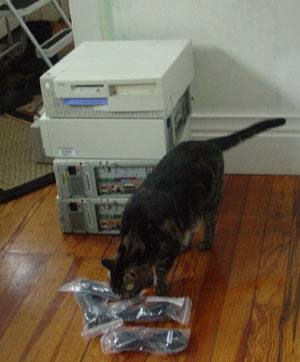
I took off the faceplates in the hope it would improve airflow. It took me a while the first time to realize how to do it. The next few times I improved greatly. There are a total of 6 tabs holding the faceplate on. In my experience, starting on the left and going towards the right is the best. First you have to click out the tab over by the CD drive, then the one to the right of the floppy/hard drive enclosure, then the one next to the power button. Then you jiggle the bottom three catches loose and pull it off. I did it by pulling down a bit, then out. I didn’t get amazingly fast at doing it, but it works.
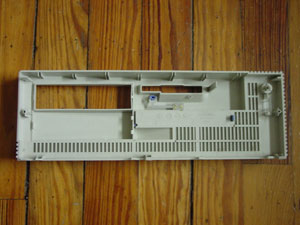
These were unaltered school machines. I was going to image the quality software that came preinstalled, but ran into a snag getting G4L to zero-out (not image) the free space, so gave up. It wasn’t worth the effort. Here you can see why:
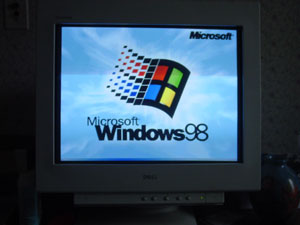
There were some problems. The first machine I started setting up wouldn’t boot from the CD. I got it working by reading the manual, (*gasp*) and finding the jumper to reset the BIOS. I really liked the jumpers – they weren’t the little connector pins, but actual switches that were very well labeled. I was very impressed with the engineering on these things. The solution was to turn on jumper 2 on switch 1. I did this, and booted up. The settings were defaulted, then I turned it off and turned the jumper back off. It acted a bit weird when I turned it on: it disabled the keyboard “for security” for a few seconds before letting me hit F1 to get into BIOS, which is what I had been trying the whole time. I got in there, and it prompted me to tell it to autoconfigure itself, (the only option, why didn’t it just do it?) which seemed nice. I’m not sure if that was just a fancy way of saying it was loading the default settings. Once in, the BIOS was very nice. It listed the version numbers of just about everything, up to the point that it listed the MAC addresses of the network card and whatnot. Once in, it was easy to have it check the floppy first, then CD, then hard drive. Problem solved.

I also had some problems with the machines missing feet, which was a problem as I was going to stack them all up and didn’t want the stack to be unstable. I was going to cut new feet out of wood, which I may yet do, but I figured it wasn’t that big a deal and didn’t bother.
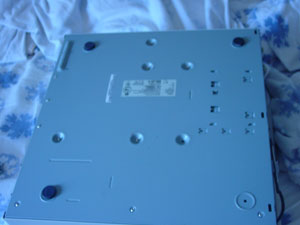
I installed Debian Etch on all the machines, and the installer was quite shiny, and the systems were very snappy once installed. These are running 728MHz “Copperfield” Pentium 3s, with anywhere from around 128 to 576MB of RAM. When I had a fresh system installed, I would log in, su, (switch to root) then apt-get update and apt-get upgrade. (nothing needed every time, presumably because it had gotten the latest from the interwebs when it installed) I then ran apt-get install sudo openssh-server boinc-app-seti. I added myself to /etc/sudoers so that I could run commands as root in my user account with sudo, then disabled root ssh login in /etc/ssh/sshd_config. (Force of habit, I guess. These aren’t open to the net.) I then figured out what worked for me to get seti@home running, thanks mostly to this guide. Here’s what I did:
$ boinc_cmd –project_attach http://setiathome.berkeley.edu/ <auth key>
$ boinc_cmd –project http://setiathome.berkeley.edu/ update
$ boinc_cmd –set_run_mode always
$ boinc_cmd –set_network_mode always
$ boinc_cmd –project http://setiathome.berkeley.edu/ resume
The auth key is emailed to you, and you can request it emailed from the seti@home site. For Rosetta @ Home, and possibly other sites that don’t email you your auth key, you may need to go through these steps:
$ boinc_cmd –lookup_account http://setiathome.berkeley.edu/ <email> <pass>
$ boinc_cmd –lookup_account_poll
I’m told this is made easier in versions after 5.8.15.
I also figured out how to set the IP to static more reliably. I think every time I’ve done it in the past, it’s been finicky and required some effort. I could get it working, but I was never really sure how I did it. Now I know. I believe every time I had tried to do it in the past, I had an active SSH session open with another machine as a guide. Having a guide is fine, but having the open session apparently made everything grumpy. Now I just run cat /etc/network/interfaces in SSH and log off, keeping the screen up. I then use the other machine’s config as a guide, making changes as needed, then run sudo /etc/init.d/networking restart . This works. The problem had always been having an open SSH connection. Hooray learning! Here’s an example:
#you might need
allow-hotplug eth0
#then
auto eth0
iface eth0 inet static
address 192.168.1.200
netmask 255.255.255.0
network 192.168.1.0
broadcast 192.168.1.255
gateway 192.168.1.1
I then realized that I wanted the clock to be sane. I installed ntpdate, ran it once pointed at ntp1.sbcglobal.net, then uninstalled it. I then used /sbin/hwclock –systohc –utc to set the hardware clock to that time. (As found here.)
When I was almost done, my cat saw fit to steal my chair:
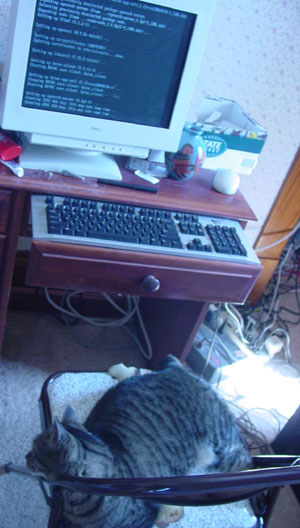
At which point I decided to take a break. The result?
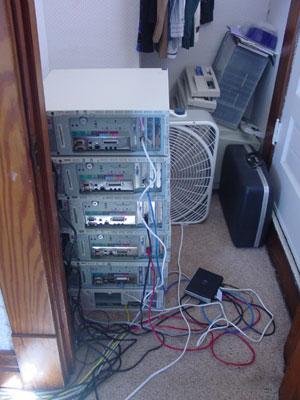
UPS Problems
Uninterruptable Power Supply, that is. My mom said it was making a screeching noise, so she turned it off and back on. Ironically, it only affected the machines that had been plugged into the battery backup side of the UPS, and not the surge protector side. Maybe it was that there was too much drain on the battery, so I moved everything but the modem, router, and server to the surge protector. I hope it doesn’t happen again. This problem ruined my 202-days-and-counting uptime on my BOINC zombie.
Computers For Sale!
The school is selling their computers! Their old ones – Pentium IIIs at 566MHz with around 512MB of DDR (I think) RAM – are being sold for $20 each! Mrs. Blasey asked me if I’d also need monitor/mouse/keyboard, which might also mean those are availible as well. Her extention is 3150.
I’m going to get four and turn them all into BOINC zombies. 🙂
Buildin’
The motherboard for the machine I’m building is set to arrive today. I’ll be able to finish up the hardware and start on the software. The first motherboard wasn’t compatable with 45-nm. :\
EDIT: The machine’s done. I like ASUS boards. They have a nicer I/O plate.
Electric Cars!
Here’s a very good idea. There’s an article on Forbes. We need to skip the whole painful hydrogen and ethanol and biofuel psudoadvancement and go right to electric cars. Solar peaks in the day, wind peaks in the night. Balance out the load by allowing utilities to borrow power back from the cars, provided the driver has not disabled this ability. (Like they’re leaving soon or something?) Really, why are we even trying to set up another flawed model of distrubution of liquids for powering vechicles? Electricity really is the renewable way to go. Besides, I remember reading somewhere that two thirds of oil in the US is used for millitary use and transporation trucks and the like. Although changes in consumer technology could definitely help, the millitary and transporation and freighting industry will need to get involved too. The article is here.
Fun With Linux
I have two things:
- Guild Wars runs perfectly under Wine, no tweaking.
- VirtualBox is interesting, and much less nerve-wracking then trying a new OS on a real system. I intend to use it to try out new distributions more easily.
Also, logical volume management sounds interesting. I think I’ll check that out later…
Computer
It’s nice to be on break!
I finished my build of a computer with the following specs:
Intel Core 2 Duo @ 2.66Ghz
3GB RAM
500GB HD
Two nVidia 8600 GTs in SLI
And Windows XP. This thing got 162.65 FPS on the Lost Coast stress test! It’s really snappy! However, I hit several snags from idea to having a working box humming in front of me.
Newegg wasn’t restocking on my nVidia 680i motherboard, so I bought it from TigerDirect. I also didn’t realize that XP’s 3GB total usable RAM limit counted video RAM. I got 3GB RAM, and the video cards added up to 512MB, so functionally I had 2.5GB non-video RAM. There’s a lesson learned.
The CPU fan was really hard to push into the motherboard. I would have preferred screwing it in, but I don’t think that’s possible with the ATX motherboard standards. It was something that required great strength. The tooless drive bays were a pain, but they managed to be fairly stable once I screwed it in. I wish they’d stop selling tooless cases – it really doesn’t help in the long term, or in stability. Then the computer kept overheating – just turning off suddenly – after sustained hard drive use. Then I remembered that hot air rises, and moved the hard drive to the lowest bay – it had been in the highest – and it stopped overheating. There’s another lesson learned.
The Windows XP installer surprised me by being really ugly and slow. When it first started up, it was text-based. It then booted from the hard drive and used a low-resolution (800×640?) GUI to configure things. While it recognized my PS/2 keyboard, it didn’t recognize my PS/2 mouse. A USB mouse worked fine though. After setting everything up, I was able to login. It turned out that nothing really worked out of the box – no sound, no networking. The driver CD included with the motherboard fixed all those problems, but seeing how Ubuntu did support sound and networking and even the PS/2 mouse/keyboard while running off a LiveCD, I was not impressed. To make me even more annoyed, when I first logged in one of the first notifications was the “Your system may be at risk.” It was complaining I wasn’t running antivirus. Great way to greet your users with a fresh system, Microsoft. At least it was just an XP install disk so it didn’t have lots of 3rd party crapware. eMachines have hours worth of it – and by hours I mean that’s how long it takes to get rid of all of it. I also learned that building a computer can be way, way cheaper than buying a new one. A used machine is about as cheap as you can get…
The rest was installing OpenOffice and Firefox, running benchmarks in Steam games, and setting up the machine again at my customer’s house. It was fun, and I even got paid! 🙂
Projector!
This guy has some interesting hardware demos up. There are others on his site, but this one is of an automatic projector calibration system. That could save lots of time, although there’s the inevitable loss of resolution. There’s another one that allows any projected-on surface to be used as a multitouch screen, provided you’re willing to use an IR “pen.”